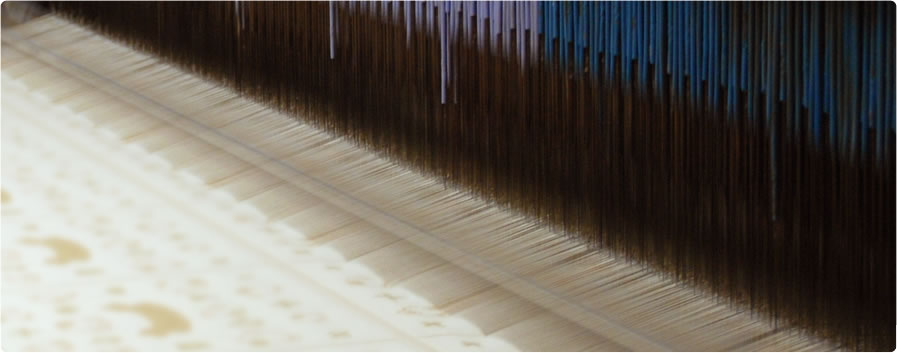
- HOME ̂Product creationWeaving

The first step in making a new textile involves imagination. Start by picturing a very functional, beautiful towel which looks like a common towel you can find anywhere, but is actually a one-of-a-kind towel. The requirements for good quality towels include: good texture, long-lasting soft texture, fast drying after being washed, excellent moisture absorption and retention, and lightweight yet with volume, some of which are contradictory to each other. Is it possible to create a towel that can satisfy all these requirements?
Letfs try making an ideal towel.
1. The first thing to consider in the designing process of a towel is the type of yarn to be used.
Towels are composed of three types of yarns: warp, weft, and pile. It is important to use a fine count single yarn for the pile to achieve functionality and a pleasant texture. Strength is the key for warp, and weft is chosen in consideration of the balance with the warp yarn. Taking all these things into consideration, we decide on each yarn.
・ Pile: loosely twisted as much as possible, #40 single soft twist yarn of organic supima cotton by Taishoboseki Industries
・ Warp: very fine count two-ply yarn of organic supima
・ Weft: loosely twisted, #40 single soft twist yarn of organic supima
(There is a reason for using very fine two-ply supima, which is an ultra long cotton, instead of general organic yarn, for warp, which is not visible when viewed from the front. You will find out why later.)
2. The next step is to think about the weave pattern and the type of loom to be used.
If a fine count single yarn is used as pile, a loom equipped with a reed, which is used to determine the warp density, is necessary.
Typical looms used in Imabari City, which is a top towel manufacturing town in Japan, have #50 reeds, which is not suitable for weaving fine single yarn neatly while keeping them aligned. So, we need to find a loom equipped with a #70 reed, which increases the warp density by 40% to 50%. However, there are only a handful of weaving factories that have this type of loom out of the 400 factories in Japan.
3. Setting the warp density, pile length, and weft density at certain levels
The ideal length and weight of pile are determined by repeating the process of making a trial model and using it. In commercialization, the pricing also need to be taken into account.
In fact, our ten-i muhou supima 40/1 towel was developed in this way?after 10 years in the design stage and 1 year of trial production. This type of new product development, in which a new textile is visualized at the preliminary meeting with the engineer of weaving factories, requires creativity and trust. Our popular fabrics are developed in this way including Supima Angel, Slub Gauze towels, the comfortable Double gauze pajama, thin and light, fine count blouses, and shawls, which are made with a low speed loom and looks like an angelfs garment, as well as baby clothes made with soft gauze textile.
Our goal is to create "textiles that look like the ordinary, but are rather extraordinary."
